Although more and more judges and lawyers are trying to use plain language instead of legal jargon, you may still hear them use unfamiliar terms to describe the parts of a courtroom. This eNews will explain the words used for things you’ll find in a BC Provincial Court trial courtroom, show you who sits where, and explain some of the customs you’ll see in court.
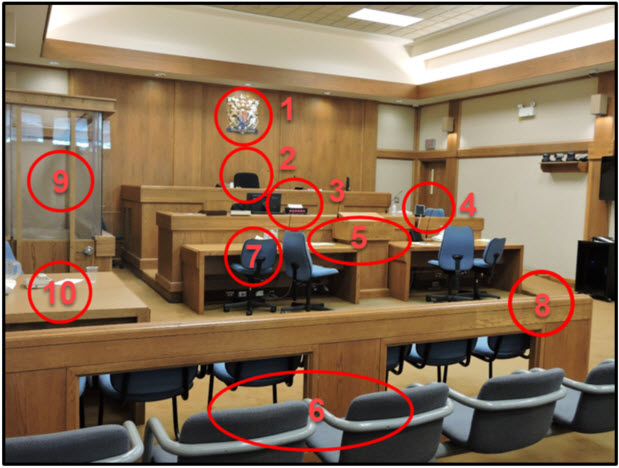
1. Coat of arms
The coat of arms on the wall of BC courtrooms is the Royal Arms of the United Kingdom. Learn more about it in: Where does the coat of arms in BC courtrooms come from?
2. The judge’s bench
The large desk at the front of the room is called “the bench” or “the judge’s bench”. The judge sits here during court proceedings. The desk has room for a computer and/or notebook, called a “bench book” that the judge may use for note-taking. There is also room for books or binders containing laws and legal reference material. There’s no gavel on the bench because Canadian judges don’t use gavels.
BC Provincial Court judges and judicial justices wear black robes in the courtroom. See Why do Canadian judges wear robes? to find out why.
The judge will enter and leave the courtroom from a door near the bench. When the judge enters, the Court Clerk will say “All rise” and everyone in the courtroom stands. People also stand when the judge leaves the courtroom. This custom shows respect for our justice system and the role our courts play in resolving disputes according to the Rule of Law.
In Canadian courts, you may not “approach the bench” for a “sidebar” – that’s an American custom. In BC courts, no one may walk behind the Court Clerk’s desk or stand near the judge’s bench.
3. The Court Clerk
In trials conducted by a judge and in many other proceedings, a Court Clerk will sit at the lower desk in front of the judge. Court Clerks have many responsibilities that are crucial to the Provincial Court’s work. For example, they make sure that the proceedings in the courtroom are audio-recorded so that typed transcripts of everything said can be produced when necessary. A digital clock on the Clerk’s desk displays red numbers that show the digital recording equipment (often called “DARS”) is on.
The Court Clerk also takes care of digital and paper case files for matters being heard in the courtroom. They use a computer to make notes about what happens, including all orders the judge makes. If you offer an exhibit (a document, photo or object) as evidence in a trial, you hand it to the Court Clerk - not to the judge or witness. The Court Clerk maintains custody of exhibits during the trial. They will hand them to the witness or judge when necessary.
The Court Clerk also has a variety of responsibilities for setting up, connecting, and facilitating virtual proceedings being held by telephone or video-conference. See the Court’s NP 21 Virtual Proceedings and Remote Attendance in the Provincial Court for information on virtual hearings and conferences.
In some hearings, such as those dealing with traffic ticket offences under BC laws, judicial justices preside without Court Clerks. Court Clerks are employed by the Court Services Branch of the Ministry of the Attorney General in the provincial government.
4. The witness box
When a witness testifies in a hearing or trial, they are first asked to step into the witness box. They stand while swearing an oath or making a solemn affirmation to tell the truth. The judge will likely then invite them to sit if they wish, or tell them they may sit or stand during their testimony. A witness box usually has a seat with a ledge in front of it to hold papers the witness may be asked to look at.
In BC Provincial Court courtrooms, witness boxes are usually located beside the Court Clerk’s desk.
Ordinarily, at the start of a trial the judge will make “an order excluding witnesses”. This means anyone who will be testifying in the trial, except for the parties involved, must leave the courtroom and wait outside until they are called to testify.
COVID note: To avoid contagion during COVID-19, all witnesses will affirm unless they bring their own holy book for an oath.
5. Counsel table and lectern
“Counsel” is another word for “lawyer”. The long table in front of the Court Clerk’s desk is called the “counsel table” because the lawyers involved in a case will sit here. However, the lawyers’ clients and people conducting their case without a lawyer sit here too, so this term isn’t 100% accurate.
Lawyers or people representing themselves in a trial stand by a raised lectern on the counsel table and use it to rest their notes when they are questioning witnesses or making opening and closing submissions to the judge.
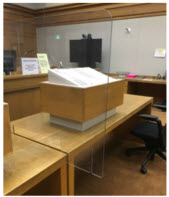
COVID note: Courtrooms being used for trials have plexiglass shields dividing the counsel table.
6. The gallery
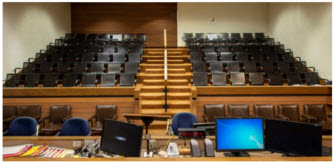
As you enter a courtroom, you’ll usually find rows of seats for spectators and people waiting for a case to be called. The seating area in a courtroom is called “the gallery”.
Cases are “called” when the Court Clerk or someone else calls out the names of the parties in a family or civil case or the accused person in a criminal matter. When a case is called, the parties walk forward and stand in the open area in front of the counsel table, sometimes called “the body” or “the well” of the courtroom. If they have a lawyer, their lawyer stands beside them. Lawyers will introduce themselves and the parties to the judge, giving their names and correct pronouns, or the judge will ask people for their names and pronouns. (See NP 24 Forms of Address for Parties and Lawyers)
People are welcome to observe most courtroom proceedings. However, members of the public may not use electronic devices of any sort to transmit or receive text, audio- or video-record, photograph or digitally transcribe, any court proceedings. Electronic devices include smartphones, cell phones, computers, laptops, tablets, notebooks, personal digital assistants, Google glasses and similar devices. It’s best to turn off any electronic device before you enter a courtroom. If you leave a cell phone on, be sure to put the ringer on silent mode so as not to disrupt the Court!
See the BC courts’ Use of Electronic Devices in Courtrooms Policy for more details. (The policy does permit limited use of some devices by lawyers and accredited journalists.)
It’s important that everyone in a courtroom remains quiet while watching court proceedings. The judge and people participating need to hear one another clearly and be able to concentrate on what’s being said. Whispering and other noise can interfere with this and be very distracting.
7. Chairs for lawyers, parties and support persons
For shorter matters, people usually remain standing. However, people who find standing difficult or impossible due to a medical condition or mobility challenge should tell the judge and ask to sit during the proceeding. People requiring accommodation for other disabilities should tell the judicial case manager or Court Registry well before their court appearance so arrangements can be made to accommodate them. Because everything said in court is recorded, if you are standing far from the counsel table the judge or clerk may ask you to speak more loudly or move closer so a microphone can pick up your voice.
For trials, hearings, and other longer matters, the judge will invite everyone to sit at the counsel table after introductions are made. When lawyers are involved, they sit beside their clients. Lawyers and litigants representing themselves then stand to let the judge know they wish to speak and wait until the judge acknowledges them before speaking. Parties and lawyers sit when the other side is speaking.
Litigants representing themselves may ask the judge to permit a support person to sit beside them at the counsel table for quiet support. See the Support Person Guidelines for more information.
While participating in any court proceeding, please wait your turn and don’t interrupt – it’s difficult for the judge to understand (and for the recording system to capture) two people speaking at the same time.
8. The bar
In medieval Europe, courts were held in different locations, including churches, halls, taverns and even outdoors under a tree. A wooden barrier (called “the bar”) was erected to identify the space being used for court. When courthouses began to be built in England, they were constructed with a bar dividing the public gallery from the rest of the courtroom. BC courtrooms follow that tradition, with a wooden or bronze railing called “the bar” separating the gallery from the body (the open space) of the courtroom.
Only lawyers and the people involved in a court case may pass through the bar to the working area of a courtroom. The use of the word “bar” to refer to the legal profession as a whole is thought to be related to the notion of lawyers “passing the bar”. Some courtrooms have chairs along the front of the bar where lawyers sit while waiting for their case to be called.
9. Prisoner’s box or “dock”
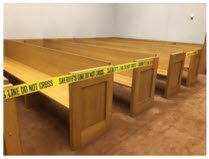
Today, an accused person who is in custody will sit either in the glass-enclosed prisoner’s dock located in a corner or at the centre of the courtroom, or with the judge’s permission, beside their lawyer at the counsel table. A defendant who is not in custody will sit at the counsel table.
10. Sheriff
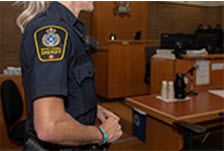
Sheriffs are provincial peace officers responsible for ensuring our courts operate safely and smoothly. Their responsibilities include prisoners’ security and maintaining order in the courtroom under the judge’s direction. There is usually a small table in the courtroom for a Sheriff.
11. Jury box
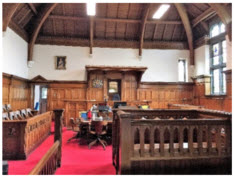
There’s no number 11 on the photo of a courtroom at the top of this article. That’s because Provincial Court judges conduct trials without juries. Our courtrooms don’t have jury boxes unless, like this one in Fernie, they are shared with the BC Supreme Court, the court where jury trials are held.
Parts of a courtroom labelled
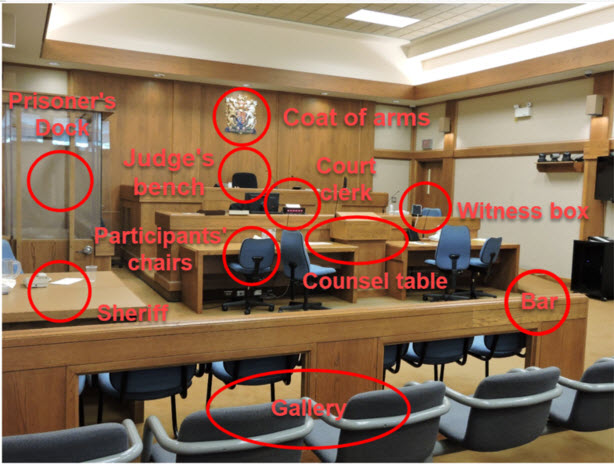
Other Resources
People in a courtroom - Government of Canada annotated poster
Courtroom layout – explanations on BC government Criminal Justice website

